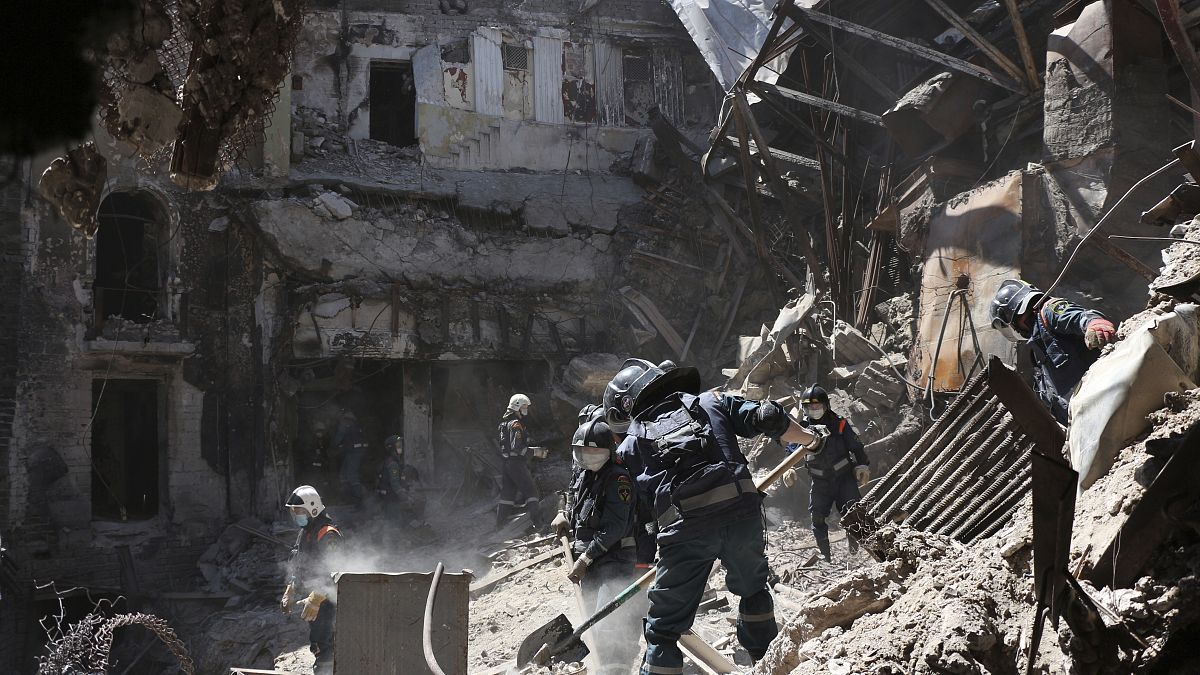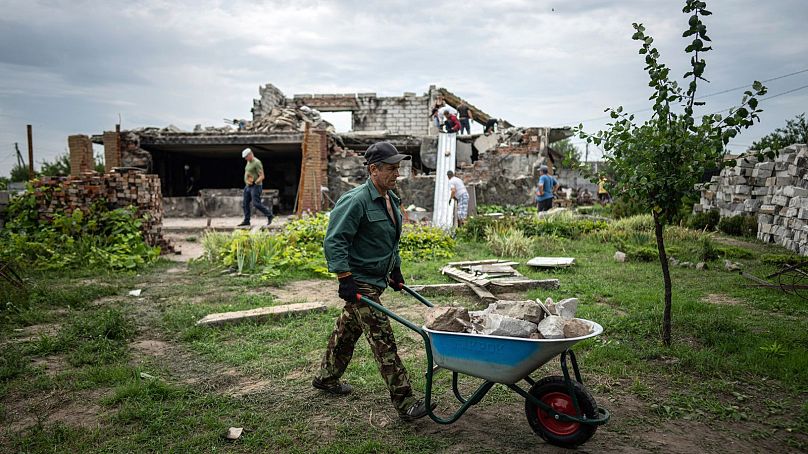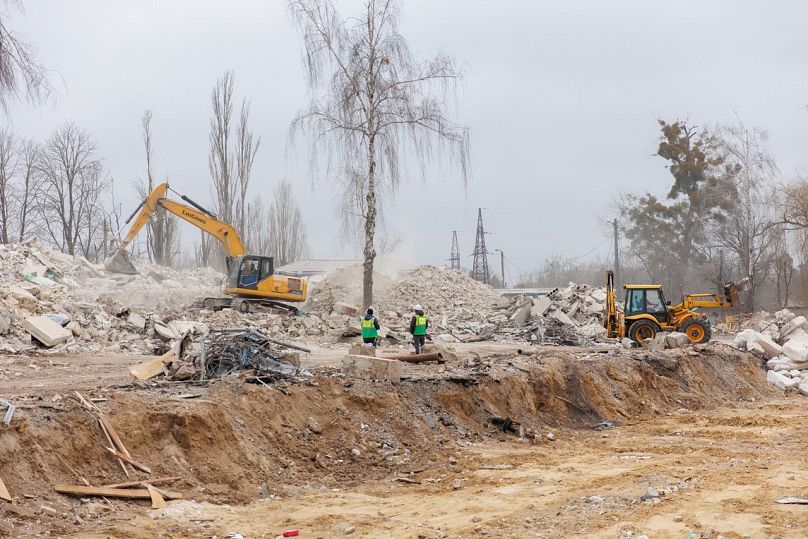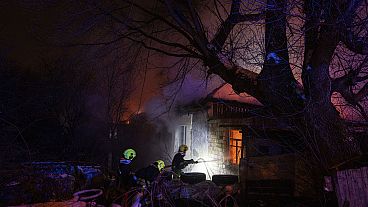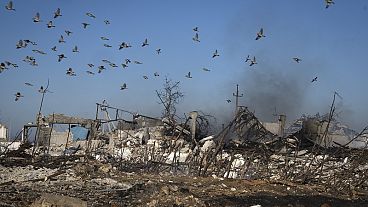70% of buildings in Ukraine are estimated to contain asbestos.
“When a bomb turns an entire building into rubble, the concrete is smashed into pieces. Everything from pieces of asbestos to old sofa cushions ends up mixed together”, Professor Matti Kuittinen, an expert in architecture at Aalto University tells Euronews Green.
Russian shelling has triggered millions of tons of asbestos to be released, forming heaps of contaminated rubble - a cause for concern given that an estimated 70% of Ukrainian buildings contain asbestos.
While the risks of asbestos contamination are reduced when it is sealed in glue or cement, once exposed these risks significantly increase.
According to the World Health Organization, asbestos is a serious carcinogen which can also trigger chronic lung conditions.
As more and more companies are beginning to recycle rubble in Ukraine, asbestos is an increasing health hazard for civilians and headache for authorities. It is also not the only material which is contaminating debris - as chemicals released from ammunition and missiles have also entered the air, soil and water across Ukraine.
Ukraine: a decade-long "dumping ground" for asbestos
"Ukraine has been used as a dumping ground for asbestos for decades. At times almost literally - as European countries exported excess stock when they banned it", explains David Hodgkin, Shelter and Specialists Settlement Expert at Miyamoto International.
Asbestos was commonly used in roofing materials, cement and adhesives. Although efforts to phase out asbestos began in 2011, these faced heavy opposition - but the material was eventually formally outlawed in 2022.
Ukraine's high level of asbestos imports have been closely tied to Russian influence, while the substance was banned in the EU back in 2005.
"Russia and Kazakhstan exported vast quantities [of asbestos] to former Soviet nation states like Ukraine along with large and clever disinformation campaigns", added Hodgkin.
Can you really remove asbestos to recycle rubble?
In Europe, a long list of harmful and toxic materials are prohibited from being recycled - and asbestos is one of them. But asbestos can be extracted - with varying levels of success - and the materials which surround it recycled.
"Making cement creates a very high burden of CO2, so re-using such cement with valuable components without the asbestos would be very sensible", says Yvonne Waterman, Founder and President of the European Asbestos Forum Foundation.
For some, recycling debris fits into 'green reconstruction' plans, a hot topic discussed at talks organised by the European Commission in Vilnius last month.
Safety standards: "We don't have access to data"
But some experts worry about whether safety standards can be adequately implemented to protect workers.
"The majority of construction sites are not equipped with the necessary equipment - and many debris recycling strategies do not take into account the danger of asbestos dust, which appears after debris has been milled", Vasyl Andreyev, Head of the Ukrainian Building Workers Association warns.
Exact figures for asbestos-related illnesses and deaths are very limited in Ukraine - in part due to the ban on the material being so recent.
"We don't have access to data. The ban was passed in 2022 but it officially came into force in October 2023 and the Ministry of Health has not been collecting this information", explains Andreyev.
But a lack of data does not mean a lack of cases - in the EU asbestos claimed almost 72,000 lives in 2019 alone.
"Although Ukraine has now banned asbestos, it has yet to produce the swath of laws and regulations required for safe removal, transport and disposal. It also does not have the medical infrastructure to conduct large scale testing into the unquantified levels of disease which asbestos will cause," David Hodgkin, Shelter and Specialists Settlement Expert at Miyamoto International tells Euronews Green.
Asbestos picking: could this be a new source of jobs?
For some businesses, recycling debris is key to a green reconstruction as well as a way of creating new jobs. One way of doing this is through asbestos sorting.
Neo-Eco Ukraine - an industrial engineering company - has experience in the matter. Specialised in waste recycling, Neo-Eco led a pilot recycling project in Hostomel, a city north of Kyiv.
"Up to 99% of our team are Ukrainian, it’s a way to create jobs and reinvigorate the local economy", says Bart Gruyaert, Project Director at Neo-Eco Ukraine.
Generating 20 jobs for locals, the three month project in Hostomel ensured no waste was deposited in landfills - meaning that 7,150 m3 of uncontrolled waste was prevented from being dumped into surrounding nature.
Neo-Eco Ukraine works to remove asbestos from the "source", before buildings are torn down, "this can mean removing a roof with a crane to examine its contents before it is demolished which is slightly more costly than regular debris removal", says Gruyaert.
Then the "picking part" follows, which involves removing the finer elements of asbestos.
"Any small remaining asbestos particles in the total volume of residual debris are minimum, and far below European Union norms for solid state asbestos allowed in solid material," Gruyaert says.
The team is currently working on another project in Mykolaiv, southern Ukraine and remains optimistic that there is still a chance for "the country to be seen as a leader in large-scale asbestos handling and management", said Gruyaert.
For other companies, recycling rubble and debris can also be a way to make use of abandoned infrastructure. This is the case for Kopach, a company which worked to process waste at one of Ukraine's largest metallurgy plants before the war.
